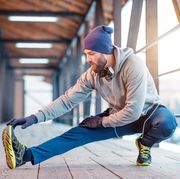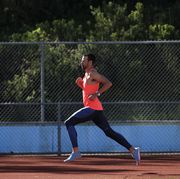By now you've heard that the running shoes you've worn the past 20 years are bad: They've become crutches that have weakened your feet, altered your stride, provoked injury and made you slower. The most zealous advocates of minimalism suggest you dump your shoes completely, while more moderate voices advise choosing minimalist shoes that allow your feet to move and cushion themselves naturally. If you agree that you should be running in less controlling, less cushioned shoes, where do you start? How do you know if you're ready, where you may be weak and what you can do to improve? What shoes should you wear now?
Because there's great variability in how ready runners are to wear more minimal shoes, we propose the following tests, directly targeting your individual limiters. Failing any of these tests doesn't mean you're relegated for life to heavy, controlling boats on your feet--by strengthening each area, following the guidelines below, you can and should begin a gradual transition to more minimal footwear. Runners who pass these tests, however, will have little to no difficulty adapting to minimal footwear over the long term.
Test Number 1: Dorsiflexion of Ankle
Sit on a chair so that your knee and ankle are both bent at 90 degrees. Keeping your foot in the same place on the ground, slide your hips forward so that the front of your knee is just past your toes. If you can't keep your heel on the ground in this position, your Achilles is too tight.
Proper flexibility of the Achilles is necessary to allow the foot to get behind the hips for effective toe-off. Without this flexibility, you'll overstress the area in lower-heeled minimal shoes, and, more importantly, change the way you store and release elastic energy, which compromises effective push-off.
How to improve:
| Do a burrito Achilles/calf stretch: This is the good, old-fashioned runner's calf stretch, with a twist. First, fold a hand towel into a burrito. Place this towel roll under your big toe only, with the outside of your foot on the ground--this "locks out" the foot, making sure that you lengthen the Achilles and don't just pronate the foot as you lean into the wall. With that leg slightly behind your body, lean into the wall, keeping your heel on the ground. Hold for three minutes on each side. (Yes, three minutes is how long research shows we need to hold stretches for tissues that are too short.) It can take 10-12 weeks to improve soft tissue length. |
For a collection of resources on minimalism, go to runningtimes.com/minimalism Test No. 2: Dorsiflexion of Big Toe
Keeping your body in the same position as the end of test No. 1, reach down and grab your big toe. While keeping the ball of your foot flat on the ground, raise your big toe up (keeping it straight) until it's 30 degrees above the ground. If you can't raise it to 30 degrees, or find that the ball of your foot comes off the floor while trying to raise it, your plantar fascia is too tight.
Proper range here allows you to roll straight through the ball of your foot at toe-off. If the plantar fascia is too tight, efficiency is compromised since your push-off is cut short. Additionally, if you can't roll straight through the forefoot, your foot will spin inward or outward--both of which decrease support from the all-important big toe, and lead to injuries farther up the leg.
How to improve:
Sit down and cross one leg over another with your top ankle on your knee. Press your thumbs firmly into the bottom of your foot. The plantar fascia runs like a triangle from the heel to the ball of the foot. Poke around for areas that feel sore. These sore places are overly restricted and bound down. Apply firm pressure and flex the toes back and forth to mobilize the area. Do this four to five minutes a day for about three weeks or until soreness alleviates.
For a podcast on transitioning to minimalist shoes, go to Test No. 3: Isolating the Big Toe
How to improve:
(1)
Balance is crucial for all aspects of an effective stride. You can't fire a cannon from a canoe, nor can you push off effectively from a wobbly stance. Specific control and stability of the muscles in the foot will ensure you get your control from the right place.
How to improve:
Why over-cushioned and high-heeled shoes interfere with your natural stride
Feet don't just lock and unlock themselves, however. They're actively controlled by the neuromuscular system. While we all know that "muscles" equal "strength," we often forget that "neuro" equals "brain." Muscles inside the foot don't just turn on and off at random; they feature precise control from our nervous system. One muscle in particular, the flexor hallucis brevis, serves a single mission in life--to actively coordinate and stabilize the arch as you stand, walk and run.
Like other structures in the body, the foot works best when it receives good sensory information on where it is and what position it's in. Firm surfaces give the foot the best feedback. Overly cushioned shoes filter this sense of feedback. Sticking the foot inside the equivalent of a marshmallow impairs feedback to muscles that are rapidly correcting foot position throughout stance. And since someone running at 7.2 mph is only in contact with the ground for about 0.17 seconds each step, this coordination of the foot needs to happen extremely quickly. Not only do overbuilt shoes impair the function of the foot on any one run--over time, marshmallow-encased feet lose sensitivity and have to relearn these specific reactions.
Four Features of an Ideal Minimalist Running ShoeProper Shoe Fit
A proper fit accounts for the natural expansion of your foot upon ground contact. The goal is to eliminate any excess material, along with everything that inhibits your foot's natural motion. In the proper shoes, your foot is free to move and work the way nature intended--the way of its own barefoot motion.
When a load is applied to your foot by running, your foot will spread up to half an inch in length.
Your foot is widest at the toes (but most shoes aren't).
runningtimes.com/apr12
The Transition
For running you might still need some assistance in controlling the foot as you progress, so choose a more protective shoe that still has the key features of a minimalist shoe (see sidebar below). Many are convinced that runners must learn better running skills (learn to run softer with less heel strike) before turning to minimalism. Others believe minimizing the interference between the foot and the ground by wearing a minimal shoe is enough to induce biomechanical corrections.
Optimizing your ability to pass the four tests above ensures that your body can keep up when you start running in less shoe. That said, even if you pass all the tests, you'll need time to adapt the tissues to working in this new "shifted" position if you've been wearing heavily supportive shoes. Some, such as Blaise Dubois at The Running Clinic, Canada, suggest adding a minute of running each day in new minimalist shoes. While this is certainly a safe route, progressively increasing your use of minimal shoes and listening to your body will provide the answer for you.
Runners can start by walking. Rapid transitions to flat shoes rarely result in catastrophic "walking injuries." Walking demands less mobility from the joints and imposes forces of only 1.1 times your body weight. For daily standing and walking, going with as little as you can get away with (close to or at zero drop from heel to toe) will demand a little more muscle activity from your foot. Throughout the day, try to spend as much time as possible on one foot, and consider a stand-up desk to encourage your feet to work for you.
If you're recovering from an injury, you may choose completely flat and thin from the start as you rebuild mileage and speed in a slow progression with walking and running. If, however, adjusting training volume and intensity isn't an option based on your current training plan, the move can and should be much more gradual.
Improve plantar fascia mobility: The plantar fascia is extremely dense, tight tissue that doesn't respond well to stretching. It's better to think about breaking up tight spots within the plantar fascia to improve its mobility. This approach produces changes quicker than stretching and is much more specific.
While standing, drive your big toe into the ground (plantar flexion) while slightly elevating your other toes (dorsiflexing). Make sure not to roll your ankle in or out to compensate. If you find that you tend to bend the joint in your big toe so that your toe curls, it's a sign that you're dominating with muscles up in your shin and not able to isolate specific muscles inside your foot.
The ability to isolate and coordinate movements of the big toe is what provides the specific control we need from the foot during the stance phase. Try to hammer a nail gripping it with only your four fingers. Pretty tough, right? Now wrap your thumb around the hammer and keep nailing. Much easier. About 85 percent of your foot control comes from the big toe. The better your coordination of muscles inside the foot, the faster you can micro-correct your position in stance.
A: Learn to isolate the muscles controlling the big toe: Sit with your foot flat on the floor and equal pressure across the ball of your foot. Place a thin book, a piece of hard plastic or a stiff piece of cardboard under your big toe. With your hand, tilt the board up. Then push straight down into the board with your big toe, keeping it straight, as you slowly resist this motion with your hand. This will teach you to isolate the big toe from the little toes. When you can do this, the test becomes the exercise.
(2)
(3)
B: Do "toe yoga": Try to raise/lower the little toes and big toe independently of each other to improve coordination. Do this several times a day until easily mastered. Since you're targeting a change in control, and not strength, improvements are rapid--usually noticeable in a few days to two weeks.
Test No. 4: Single-leg balance
Get in good posture and balance, then lift one leg and balance on the other foot. Try not to shift to the side. A triangle between the inside ball of your foot (first metatarsal), end of your big toe, and outside ball of your foot (fifth metatarsal) should remain in solid contact with the floor. Good balance means you can stand on one leg for 30 seconds with full foot contact and a quiet upper body. Taking any part of your foot off the ground makes you less stable. Flailing arms and a wobbly trunk mean that you're using other strategies to get control, ones you can't use when running effectively.
Do a single-leg stance: To use the forefoot for balance, you first need to have weight equally over your forefoot and rearfoot. Too many runners have a habit of standing in the back seat with weight over the heel. To find the correct position, place one hand on your belly button, and one hand on your sternum. Drop forward slightly at the waist (not the ankle and knee) until you feel weight equally distributed over your forefoot and rearfoot. With your big toe firmly pressed into the ground (you did pass the toe yoga test, right?) try to stand quietly for 30 seconds at a time. Do this with your eyes open and closed; try rotating back and forth or throwing a ball with someone or against a wall to increase the difficulty. Balance training is best done in short spurts of 20-30 seconds multiple times a day rather than in one 10-minute block. You can do this when brushing your teeth, making lunch, or pouring your cereal. Most runners are surprised at both how bad their balance is, and how quickly it can improve. It can go from poor to excellent in a few weeks since improving it involves training the neuro-muscular system.
Necessary Physiology
The foot is a marvelous structure, made up of 28 bones and four arches, that serves as our starting point for balance, stability and forward motion. Some of those bones, such as the calcaneus, metatarsals, and toes, are in contact with the ground. Others are suspended and form an arch between the contact points. These arches are designed to move, rather than being upheld and locked in a position by a shoe with "good arch support." As you run, the foot moves into locked positions (supinated) and unlocked positions (pronated). Thus the foot stiffens to a rigid lever to apply power for push-off, and unlocks to act as a natural shock absorber during stance.
Important in understanding the motion of the foot and the muscles that control it is that strength is nothing without control. And control requires sensitivity. Consider tying your shoes with your fingers coated in marshmallows. All those marshmallows prevent you from feeling the laces and make it hard to use your fingers. You feel clumsy and uncoordinated.
In addition, running shoes with a heel height that's twice as high as the forefoot (as most of us have been wearing for years) produce more of a rocker effect, meaning less mobility is required at the ball of the foot compared to a flat shoe. In such shoes, the Achilles tendon and the plantar fascia and calf have adapted over time to operating in a shortened position. A transition to a shoe with less drop from heel to forefoot, enabling the full push-off ability of your foot, requires increasing the length of both the Achilles and the plantar fascia.
See
Improper shoe sizing and shape are the primary cause of ingrown toenails, bunions, corns, hammer toes and hallux valgus. Shoes that don't fit your feet correctly can also lead to muscular imbalances in your body, opening the door to foot, knee and hip injuries.
Factors to consider in proper running shoe fit:
If allowed, your foot will splay 15 percent in width under load.
See for tips on properly sizing your shoes.
Many long-time runners don't pass any of the functional tests described above. They have a structural, strength, or mobility issue that doesn't allow the ideal foot function. Does this mean they can't get into a minimalist shoe? Absolutely not.
The jury is still out on these questions, and it may depend on individual differences. The testing described above is based on lab and real-world data from successful transitions by many runners. Thinner shoes will alter your running biomechanics without your being aware of it. Until you develop strength and stabilization in the foot and leg, even short distances of barefoot or minimalist running can cause injury (see "Minimalist, Heal Thyself" on p. 48). The foot and lower leg aren't passive observers, but team players in this process.
The definition of minimalist footwear is gray. The combination of the slope of the footbed and its height off the ground leads to a number of possibilities. You may find a shoe that's completely flat from heel to toe, but higher off the ground than another model touted as minimal that has a ramp from fore-to rearfoot, yet is closer to the ground. Where should you begin?
In contrast to walking, running produces forces of 2.5 times your body weight, while landing 1,200 or so times a mile. Rapid shifts in shoe geometry result in pronounced changes to how your body absorbs and adapts to these landing forces. How far to drop depends on your individual needs.
A good rule of thumb is to start by choosing a shoe with half of your current heel-to-toe drop. If your current shoe has a drop of 12mm, moving to one that has 6-8mm results in considerably less stress to your body and impact on your training volume than a more aggressive drop. As your body adapts, the end goal will become clearer for you. Some will find that getting to 100 percent flat is where they're happiest, and some will find that they're happiest and efficient at 3, 4 or even 6mm. Not getting to zero drop doesn't mean you've failed. You're investing time to improve the function of your foot--no matter what's laced on your foot, you've found an end goal that is working for you.
Related:
Minimalist running shoes
More From Runner's World

